Girolamo Cardano
(1501-1576)

Girolamo Cardano was a sixteenth century mathematician and physician who made an important adaptation to the design of the camera obscura. He was born on September 24, 1501 in Pavia, Italy, the illegitimate son of a prominent lawyer. He was sickly and impoverished in his youth, but managed to receive an education at universities in Pavia and Padua. He was refused admittance to the College of Physicians at Milan due to his heritage, but was awarded a degree in medicine in 1524 from the University of Padua.
Cardano received an appointment as mathematics chair at Milan in 1532, but continued to practice medicine. He gained a reputation for disagreeing with contemporary medical practices, but was eventually accepted into the school that had previously rejected him and much later was appointed rector of the college. Cardano published a wide variety of works in the medical field, covering such diverse topics as how to teach the deaf and the blind, how to treat syphilis, and how to determine one's character based upon facial expression. Over the years, he became one of the most well known physicians in Europe and accepted a professorship in medicine at the University of Pavia in 1543.
In mathematics, Cardano was equally successful. In 1539, two of his books on arithmetic were published, and, in 1545, Ars magica, the first notable work on algebra, was released. He was one of the first mathematicians to recognize the existence of square roots of negative numbers, now referred to as imaginary numbers, but was also an avid gambler. His interest in dice, cards, and games of chance led to his early development of probability theory. His systematic study and computations were published in Liber de ludo aleae, almost a hundred years before any other important publications on the subject.
Cardano's most popular works during his lifetime, however, were De subtilitate libri, published in 1550, and its follow-up De subtilitate rerum, published in 1557. The works covered a wide array of topics and contained natural history, anecdotes, physical experiments, and inventions. It was in De subtilitate libri that Cardano made his primary contribution to optics. Within the work, he described the use of a bi-convex lens in conjunction with a camera obscura, the earliest known mention of such a design. He also included detailed descriptions of the improved images he was able to achieve with the configuration, which increased both sharpness and intensity.
Despite a successful career and the publication of over 200 works, Cardano's life was filled with turmoil. He married Lucia Bandarini in 1531, but she died in 1546, leaving Cardano the sole caretaker of three children. His eldest son, who was on the track to becoming a successful physician like his father, was convicted of poisoning his wife and beheaded in 1560. The tragic chain of events was extremely distressful to Cardano, who was further affected when he lost his teaching position because of the scandal. He was, however, offered a position at the University of Bologna and soon relocated to begin work there.
Yet, Cardano's troubles were not over. He suffered another great loss in 1565 when his ardent student and collaborator Ludovico Ferrari died from poisoning. Then, in 1570, Cardano himself became the center of controversy for casting the horoscope of Jesus Christ and attributing the events of his life to the stars. He was convicted of heresy and imprisoned. To gain his release, he was forced to promise to give up teaching and his long career abruptly came to an end. Upon the advice of friends, he moved to Rome, where he lived a quiet life until September 21, 1576 when he died, just three days before his seventy-fifth birthday.
